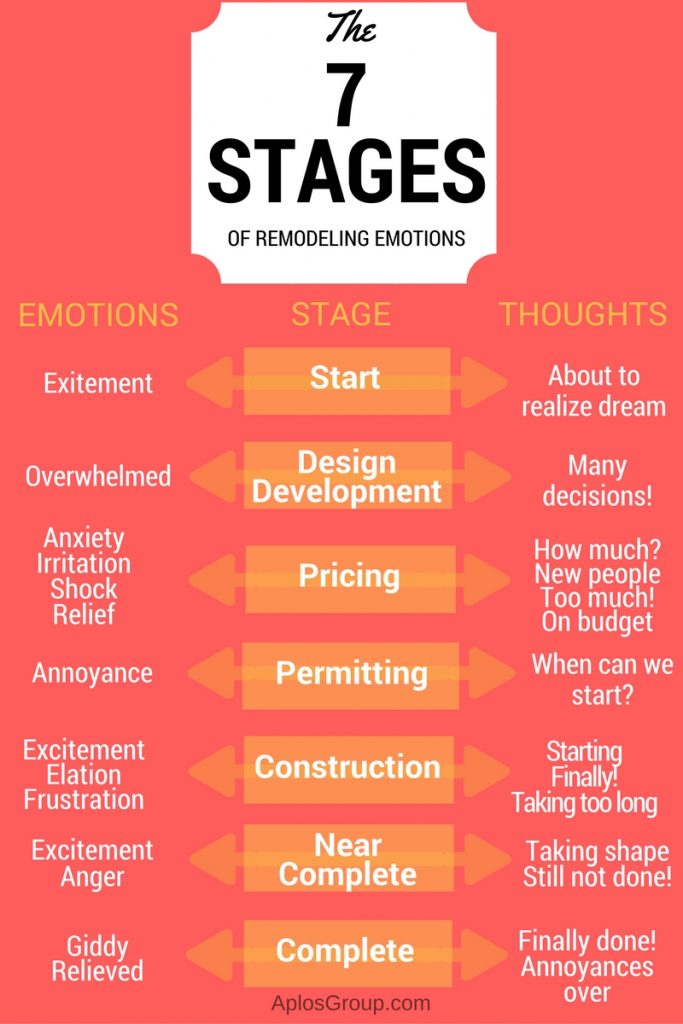A major remodeling project brings with it lots of different emotions.
Excitement. Frustration. Anger. Elation.
If you’re doing a major building or remodeling project, chances are you’ll experience all these emotions – and more – during the process.
As an architect, I’ve seen it time and again, and each time I’m right there with the client, going through it all.
I’ve found that it helps to explain at the outset what you might feel as you move through your project. You’ll still feel all the emotions, positive and negative, but having an idea of what to expect can help you recognize and manage them without feeling like you’re going crazy.
The 7 Stages of Emotion in a Remodeling Project
In my 30+ years of experience, these are the stages most people go through during a big building or remodeling project:
1. In the Beginning
You’ll likely be very excited – you’re about to start work on realizing a dream. You’re full of ideas, and discussions with your architect and designers have stoked your imagination.
Everything is new and possible.
2. Design Development
You may start to feel overwhelmed with the decisions you need to make: Do I want a 30″ or 36″ sink? What are the pros and cons of each countertop material?
Having to make choices about every tiny detail is getting on your nerves, but remind yourself that this is your dream, and it’s worth working for. Trust yourself to make good choices, but don’t hesitate to ask your architect or designer for more direction.
3. Budgeting and Pricing
There are a lot of potential emotional landmines during this phase.
Anxiety and irritation as your architect brings in new people, like contractors. You’re dealing with new personalities who have different ways of working and varying timeframes and response times.
Shock if the estimate is significantly higher than you expected, or relief if it’s near or under budget.
Remember that undertaking a major building or remodeling project isn’t like buying a widget, or even a car. There are so many components (and costs) that it’s hard to make better than a ballpark estimate until most of the design decisions have been made.
Productive, respectful communication is especially important during this time. Your architect will work with you to make any adjustments to the design to make sure it fulfills your dreams and fits your budget.
4. Permitting
Annoyance. There’s no way around it. Although I give most clients a rough estimate of 4–6 weeks, it can take longer, depending on a host of factors that aren’t in the architect’s or contractor’s control.
Everything from staffing turnovers to an uptick in the number of projects coming into the permit office can delay things.
Be patient. It will happen. We can use this time to drill down into the details of exact colors and textures of finishes. Take a breath and reflect on the fact that the big moment is about to arrive …
5. Construction
This is one of the most exciting times for a client.
When groundbreaking or demolition begins, you’ll likely be elated. Finally, it seems like this project is really happening!
After about a month passes, you might start feeling frustration. What’s taking so long?
Even if your architect has warned you that the remodeling project will take several months, you’re eager to see some – any – progress.
This is when the little snags and delays – out-of-stock items, contractor scheduling conflicts – start to crop up. Remind yourself that Rome wasn’t built in day – and even the Romans probably had supplier problems! It will get done.
6. Near Completion
You’re excited that your project is finally starting to look like your vision.
Your excitement also has a flip-side: anger at the little things that still aren’t completed or correct.
Hang in there, you’re in the home stretch.
7. Completion
Congratulations!
Not only are you giddy at seeing your dream realized, but you’re relieved at finally getting all those people and all that mess out of your house.
Take some time to reflect on the process. What went well? What could have gone better? If there’s something you particularly liked or didn’t like, let your architect know. Each project is a learning experience, both for you and for your architect.
Now break out the champagne and celebrate!
This post first ran in 2016.



